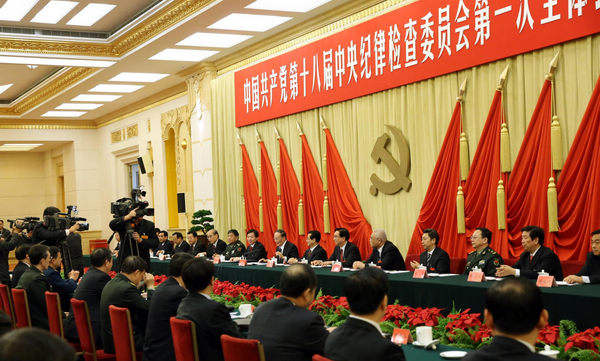China's 2020 blueprint to ripple through world
(Xinhua)
Updated: 2012-11-11 22:30
BEIJING - After the Communist Party of China (CPC) fleshed out the national goal of building a moderately prosperous society, questions of how the country will fare in 2020 and the impact on the world are very intriguing.
Optimists envisage higher productivity and efficiency and broader democracy. Pessimists warn of domestic social ills which might take a serious toll on the world's second largest economy. Others, with reserved confidence, stay skeptical.
Whatever kind of development trajectory China takes during the coming eight years, the ongoing national congress of the Party, with a new leadership to be installed next week, is a noteworthy event for its potential to change China and the world.
Potential & benefits
With the country's urbanization rate slightly exceeding 50 percent in 2011 compared with 39.1 percent in 2002, Chinese cities will see a constant influx of rural migrants in the next decade. This will generate demand for infrastructure and public utilities.
China's growing appetite for energy and raw materials is expected to give a kick to the world's sluggish bulk commodity market. Currently, China is the world's biggest consumer of aluminum, cooper, iron ore and cotton.
Ungad Chadda, senior vice-president of Toronto Stock Exchange, a world leader in mining and energy financing, takes China's 2020 blueprint as good news and is fascinated at the buildup of infrastructure under Chinese leaders.
Other market-moving elements relating to China's 2020 goal, Chadda said, include the emerging middle class and Chinese people's growing consumption power.
Morgan Stanley China has projected a golden decade for China's consumption. By 2020, the country's total retail sales will be equivalent to two-thirds of that of the United States and will account up 12 percent of the world's aggregate, it said.
For many Chinese people, the global market is no longer a vague concept.
Ge Haoxin, a delegate to the Party congress from Fuyang city in East China's Anhui province, believes that his seed-breeding business can contribute to the stabilization of the world farm produce market.
Following bumper harvests for eight consecutive years, China has witnessed an unusual spike in grain imports this year, triggering market speculation on its growing dependence on the world market.
From January to September, China's cereal imports (rice, wheat, corn and barley) more than doubled to 11.43 million tonnes, adding the total volume of farm produce imports to $83.6 billion, up 24.5 percent from the same period last year.
The deficit in China's farm produce trade rose to $38.26 billion in the nine months, up 61.9 percent year on year, according to statistics from the Ministry of Agriculture.
Restricted by its growing population and limited arable land resources, China must increase agricultural input to meet rising grain crop demand,industrial analysts say.
China is at a disadvantage compared to other major grain producers, such as Australia, America and Brazil, in terms of per capita arable land and water resources, Ge said.
"If the Party honors its commitment to nurture agriculture with industrial proceeds and facilitate innovation on farming technologies, I think we can contribute more to domestic grain supply and the stability of the world farm produce market," said Ge.
Ambition & challenges
The CPC has no intention of checking the country's economic ambitions. It will continue to view economic development as a major job.
At the previous Party congress in 2007, the target of quadrupling the per capita GDP of the year 2000 by 2020 was set. At the ongoing congress, the Party announced that it aims to double the 2010 GDP and per capita income for both urban and rural residents by 2020.
Delegate Zhang Yuyan, chief of the Institute of World Economics and Politics under the Chinese Academy of Social Sciences, said the 2020 blueprint shows the Party's down-to-earth spirit and principle of doing its own job well.
Managing to improve people's living standards when China's productivity is low is a test facing the Party, he said.
China ranked 77th out of 213 economies in 2011 with a per capita gross national income of $4,940, according to World Bank data. The global average was $9,491 last year.
Over the past 30 years, China has reduced its poor population from 250 million to 26.88 million, becoming the first country to fulfill the United Nation's millennium goal of cutting the destitute population by half.
Last year, the Chinese government raised the country's poverty threshold to 2,300 yuan, which increased the country's poor population to 100 million.
"I see no chance for China to be a challenger of the global order after 2020. But with rising national strength, it can be more extensively integrated into the changing international community. It can contribute more to the world economy and boost the reform of existing international order to better protect the need of emerging economies," said Zhang.
If China succeeds in economic restructuring by relying more on domestic consumption and technological advancement, the rebalancing of world economy will be a less arduous task, he said.
With labor cost rising, China cannot rest on its past glory as the world's "manufacturing plant." It should fuel its comparative advantages across the global value chain through higher productivity.
Related Stories
China boosts economic diplomacy 2012-10-10 09:08
Strategic industry blueprint 2012-05-31 10:42
London taps into Beijing blueprint 2012-05-09 08:02
China to move forward despite difficulties: Kissinger 2012-11-11 21:37
Delegations deliberate nominees for new central leadership 2012-11-11 19:07
Decoding China's political logic 2012-11-11 17:09

Top News
Xi emphasizes adherence to CPC Congress spirit
Top legislator urges implementation of congress spirit
Moderately prosperous China brings chances to world
Video







